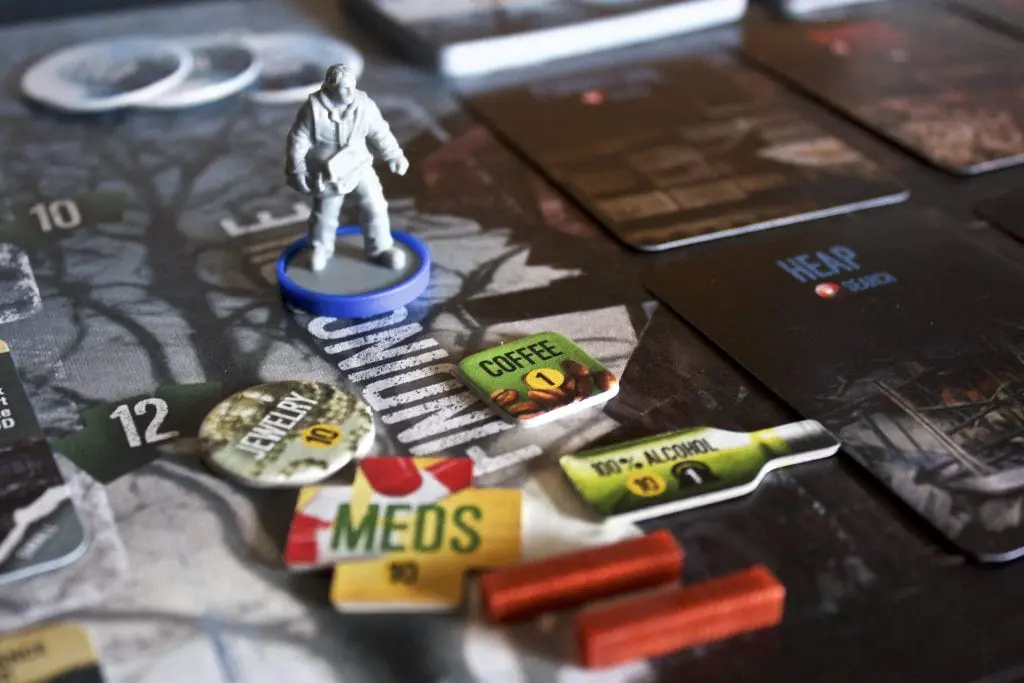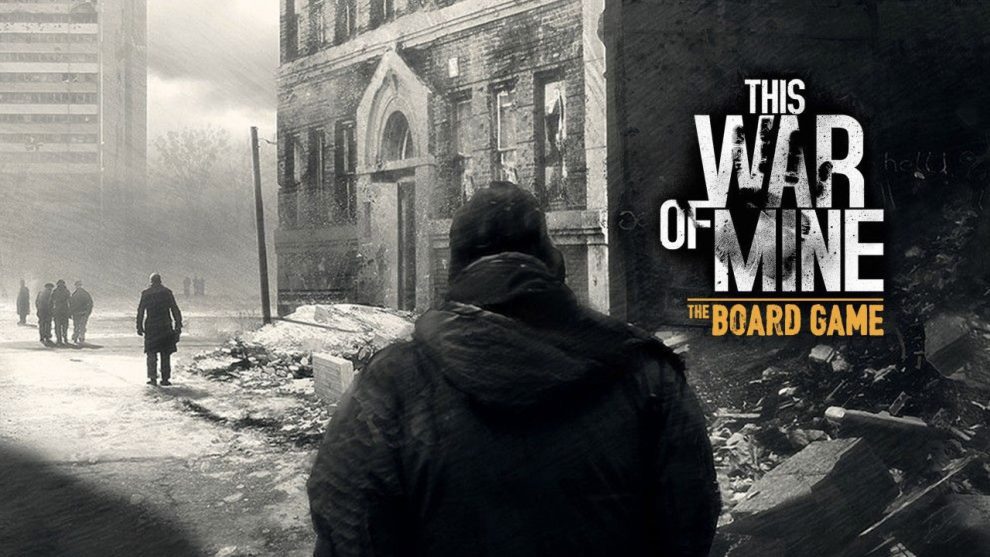Disclosure: Meeple Mountain received a free copy of this product in exchange for an honest, unbiased review. This review is not intended to be an endorsement.
On the fields of fantastic realms. In the outer reaches of space. WWII and Feudal Japan. On tabletops and flat screens, gamers have fought a lot of wars. But as Galakta Games’ This War of Mine and its video game predecessor remind us, Not everyone in war is a soldier. Some don’t fight for glory. They fight just to survive.
The game puts you in the shoes of some of these non-soldiers, as you pass the time holed up in a collapsing squat, waiting for a ceasefire. Until then, you’ll spend your days crafting makeshift appliances, setting rat traps so there’s protein in your pantry, and combating the cold by burning wood that could have been a bed, or books that could have taken your mind off the misery. When night falls, you’ll send scavengers out to scrape up a meager handful of the supplies you need to survive the next day. If it’s not yet clear, This War of Mine is a bleak affair that earns every second of its 18-years-and-up maturity rating.

Based on a video game of the same name, play passes a bit like The Sims, where the characters you control have constant and shifting needs you must address in order to advance. But instead of building the dream home they’ve always wanted, success in TWOM equates to avoiding starvation, illness, injury, or despair. All of which, you’ll find, are the only things in abundant supply.

And winning the game doesn’t feel like a triumph. It’s just plain survival in a situation where the deck is thematically and literally stacked against you. But you don’t get the sense, like in Pandemic, that you’ve brought your unique talents together to overcome impossible odds. You just feel lucky you didn’t die.
A day defined by pain.
Each phase is broken into a part of day, and you won’t look forward to any of them. Morning gives you an event card with food shortages, attacks, and worse, all accompanied by intensifying cold. Home maintenance occurs during daylight when hunger and fatigue will keep you from completing the many tasks the situation demands. Dusk is where you’ll find there isn’t enough food and water to go around. And evening is where you’ll decide who rests, who guards from scavengers, and who goes out scavenging for you.

The bulk of the action takes place at night when one or more of your group searches for supplies. The design of the raiding phase is where the game flexes its most clever design. Your hand of exploration cards indicates what happens as you look around. You can only explore for as long as you have cards, which can be spent facedown to avoid conflicts or flipped over to take your chances with what’s around the corner. Some will trigger random events, which are resolved by reading a section from The Book Of Scripts. After flipping to the corresponding reference number (1 of over 1900, so it’s unlikely you’ll get the same result twice), you’ll discover whether you’ve encountered someone desperate, someone threatening, or someone who can be taken advantage of. Any of these events could affect your various statuses (wounds, misery, etc.) but may provide uniquely useful items for the tough road ahead.

Making noise raises the threshold of failure on your 10-sided “fate die”. Kicking open doors may save you a hand of exploration cards, but increases the chances you’ll draw unwanted attention. But regardless of how your scavenge goes, you’ll need everything, and you’ll only have backpack space for a few things. So the game gives you no shortage of tough choices. It’s war, after all.
There but for the grace play I.
The Book of Scripts doesn’t spare you any weight from the game’s very heavy theme. In one scene, the survivors watch a news story about the conflict on YouTube. Then they make the mistake of reading the comments where people in a safer part of the world mock and dismiss their suffering. In my game, this was the straw that broke my character’s back. Having been made too miserable by the world’s indifference, he chose to end it all. This meant I lost, but it was a loss I felt harder than in any game I’ve played (I’ve never packed up Azul while holding back tears). The irony that I was playing a simulation of a war from the same comfort as these callous YouTube commenters only made it all heavier.
If you do find yourself in combat, you’ll probably lose. Based on what weapons you have (if you’re lucky enough to have any), you’ll roll the corresponding combat die (gun, blade, or bare hands), and maybe deal a hit, but your opponent will probably deal more. If you die, you forfeit everything you worked so hard to scavenge. And even if you win, the rewards will be paltry. And that’s the point. It’s a war game that reminds you that in war, there’s a lot more to lose than to win.

It’s the kind of game that makes you question what actually is fun. Every session I played reached a point where it was inevitable I would fail some three or four turns before I’d get to actually experience that failure. But I stayed in, regardless. Because experiencing the struggle was nothing if not immersive. I would recommend more people play it, except I don’t think it quite hits the target of being a good port.
Falling down the digital divide.
One thing the board game borrows from video games is that, instead of a big instruction manual to learn before your first play, the game throws you right in with a simplified tutorial. Called “The Journal” it walks you through setup, and then step-by-step through every phase of the game. Any rules not covered in this guide are detailed in the FAQ sections contained in The Book of Scripts. Beyond that, all instructions are delivered by components.

It’s a great approach. Players fly through the hours-long game without having to refer back to a manual too often. And if you can’t finish, the game provides a save system to set up and play again later. But the amount of admin that goes into recording and resetting the game just adds so much overhead to a process that already drags with administrative tasks. Much of TWOM has these well-intentioned elements that only provide a good experience in theory.
The pace suffers because it takes players minutes to do what code would do in milliseconds. The cooperative design allows up to six players to take turns being in charge of the entire party. No single character belongs to any player, which feels a bit like playing a one-player game with six people’s hands on the controller at the same time. The quality components and the hefty Book of Scripts may add up to the $70 MSRP, but the video game will provide a tighter gaming experience overall (and for much less money).

Still, you’re sure to discover some small part of the frustration, sadness, and pain of life steeped in the fog of war. It’s one of the most satisfying, if not necessarily fun, board game experiences I’ve ever had.










Nice write up. I have this game and your review sums up the experience fairly accurately. In fact, I would say this game is more of an experience than a game. Is it fun? No, not in the sense of what is usually designed as fun. I think of it like a film. Some films are light hearted fluff while others are weighty ponderous affairs devoid of humor. It doesn’t mean that one is less enjoyable than the other, just different experiences. This is an important game showing that war is not a guns blazing hero action adventure.
Thanks for the review!
One annoyance I had with the video game was that it felt less survival than grocery shopping. 😛 The base told me what I needed to craft something, but I had to write it down so I knew what to scavenge for. Hopefully, with a boardgame, you can “cheat” with takebacks or oopsies that a computer game won’t let you do!